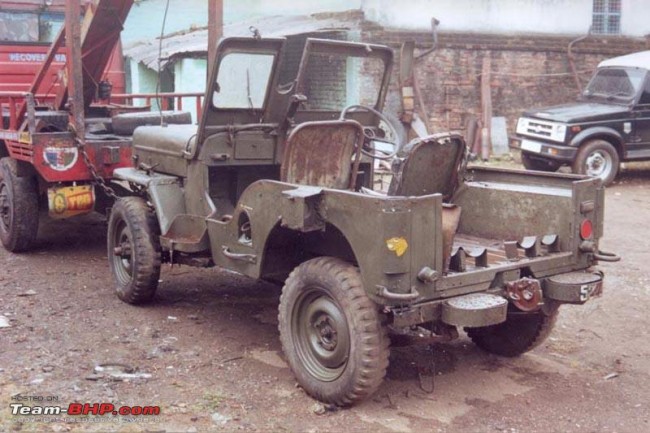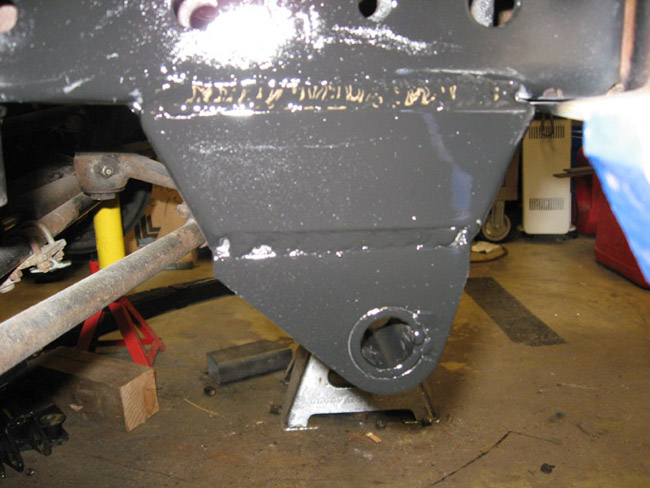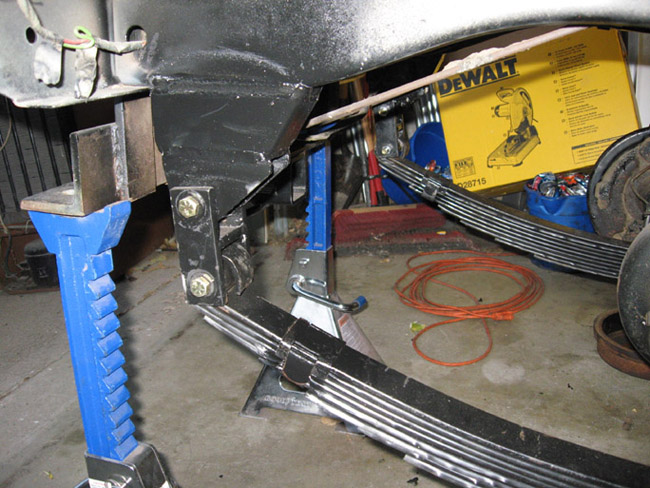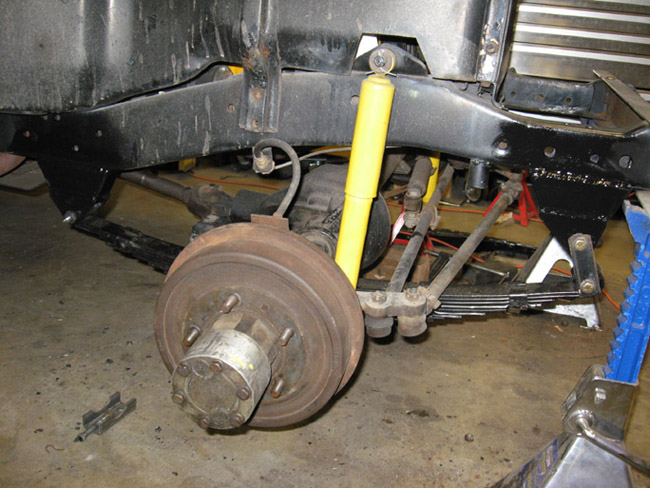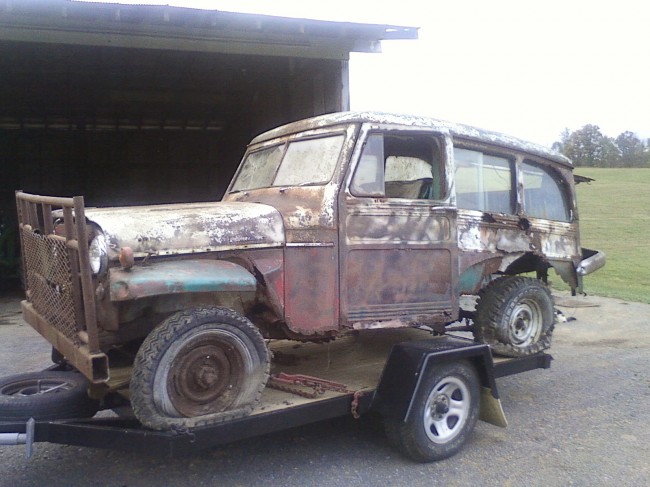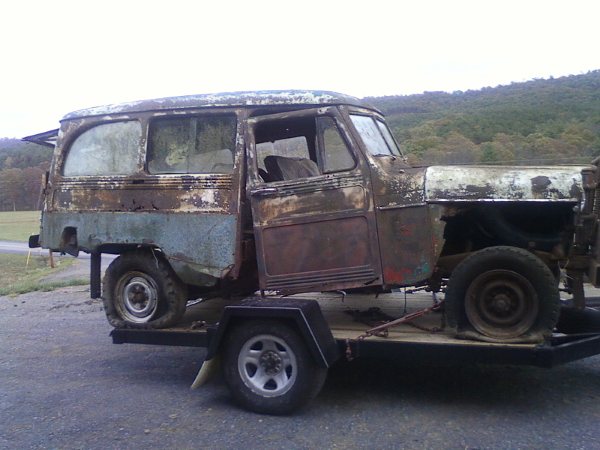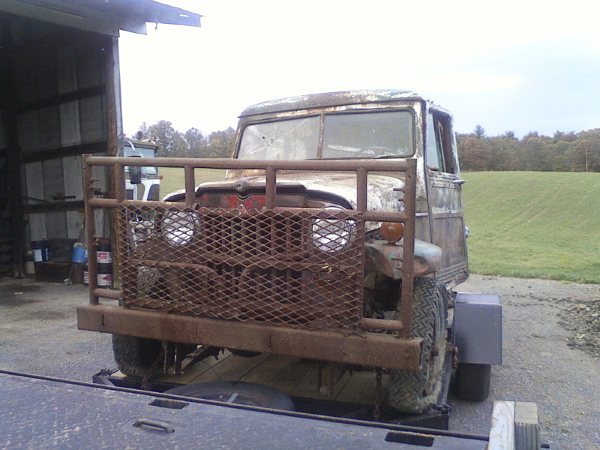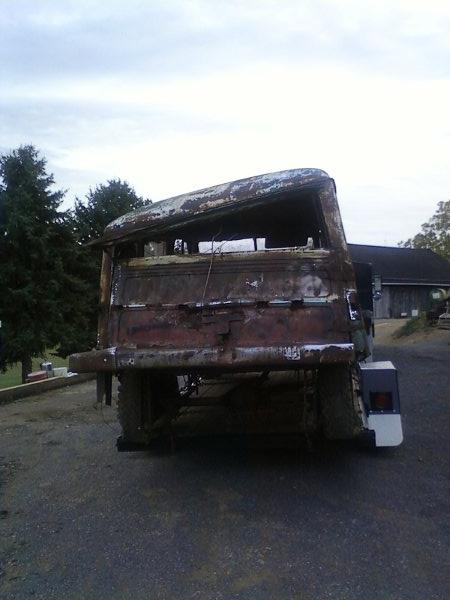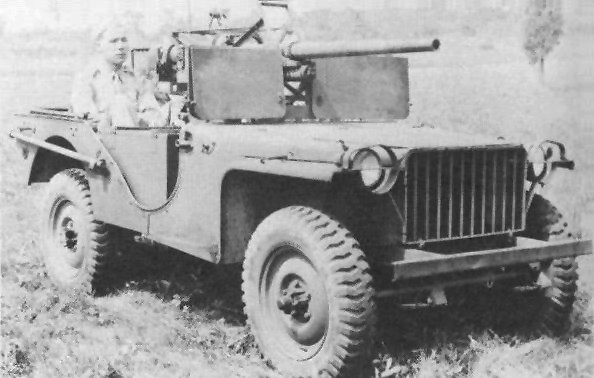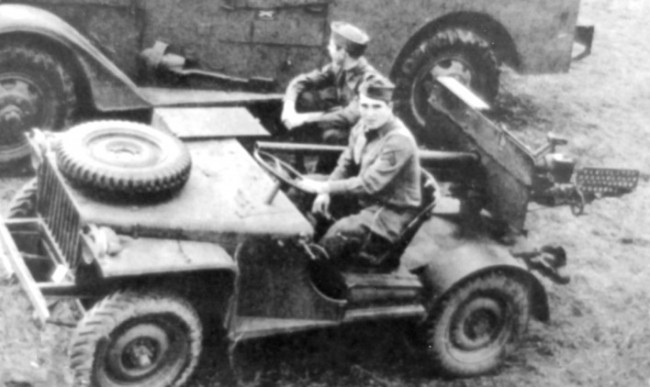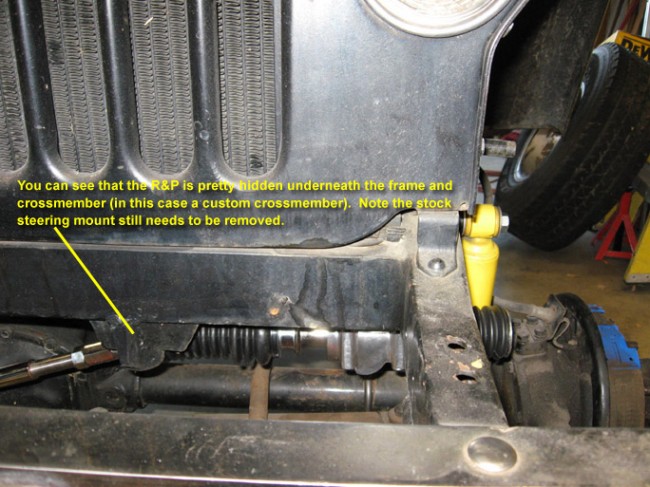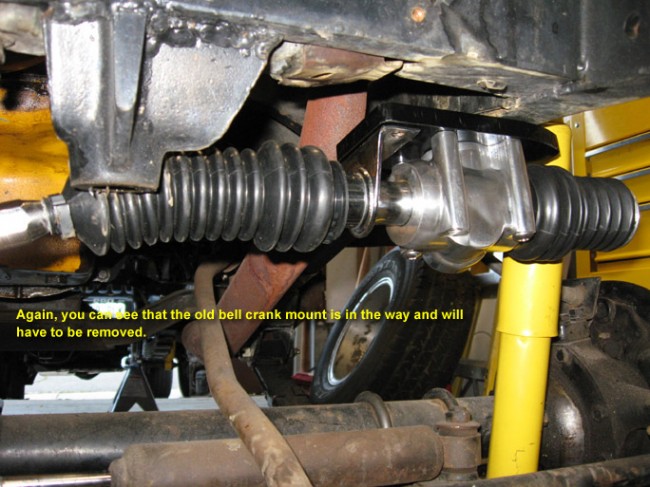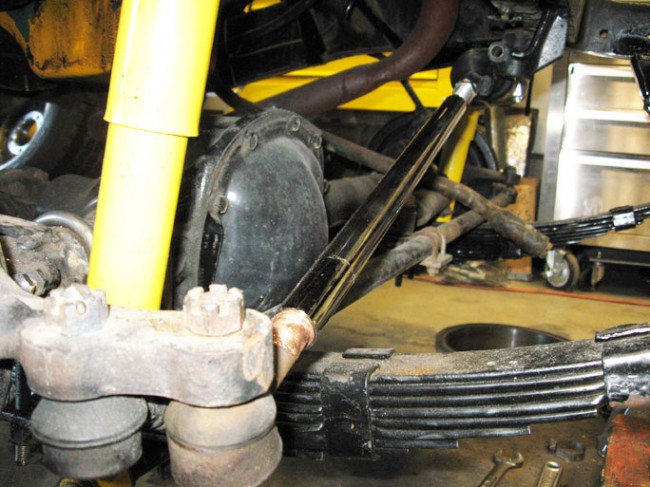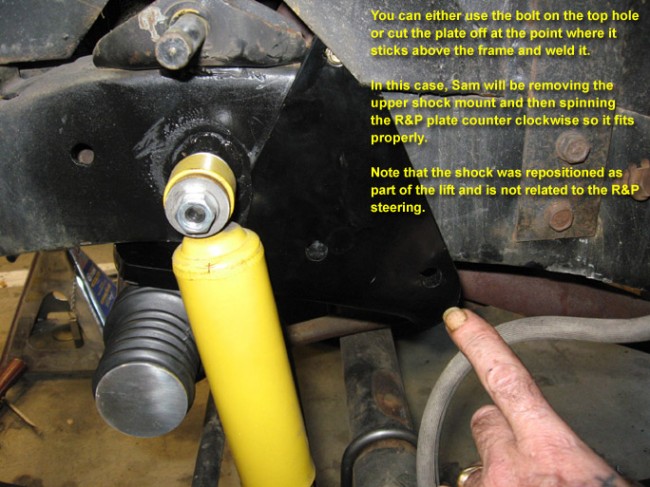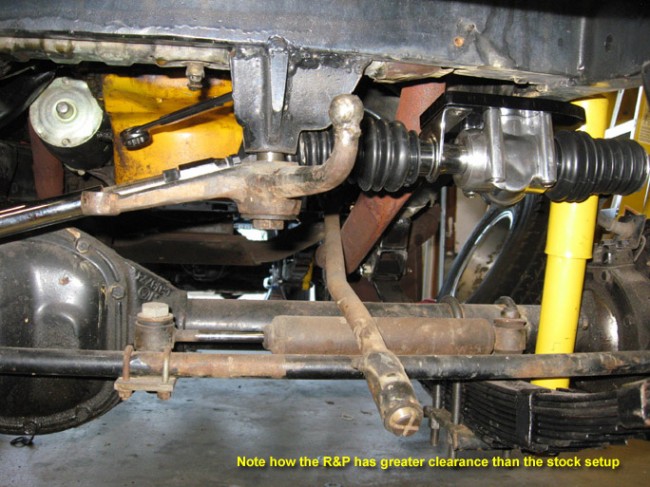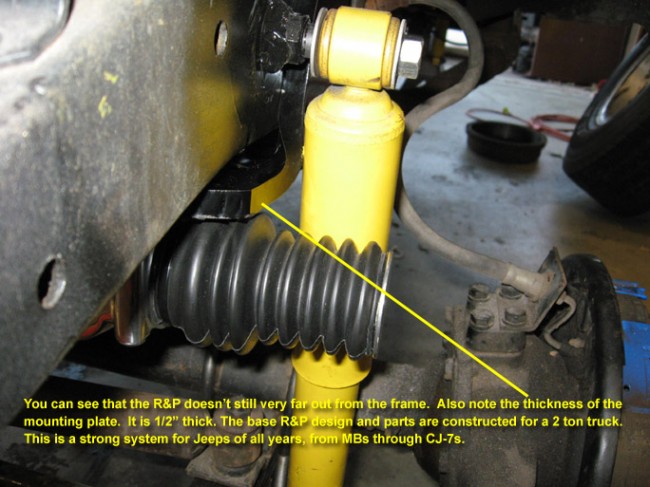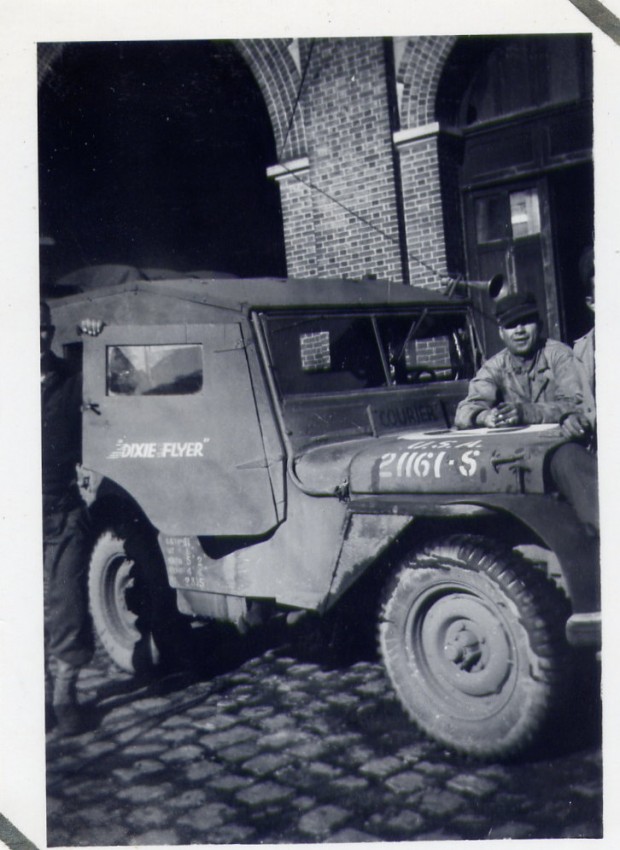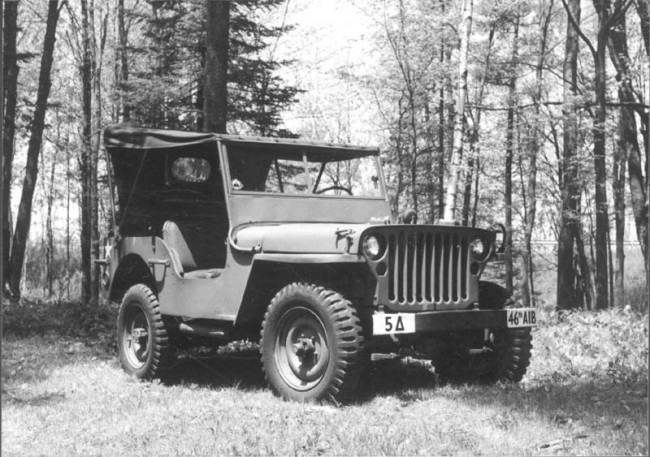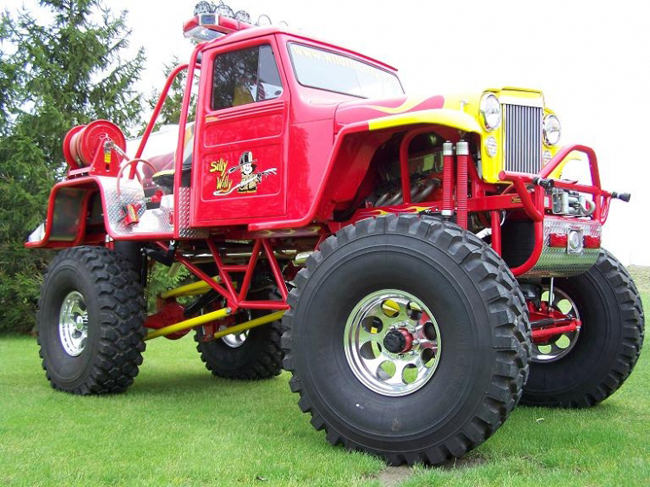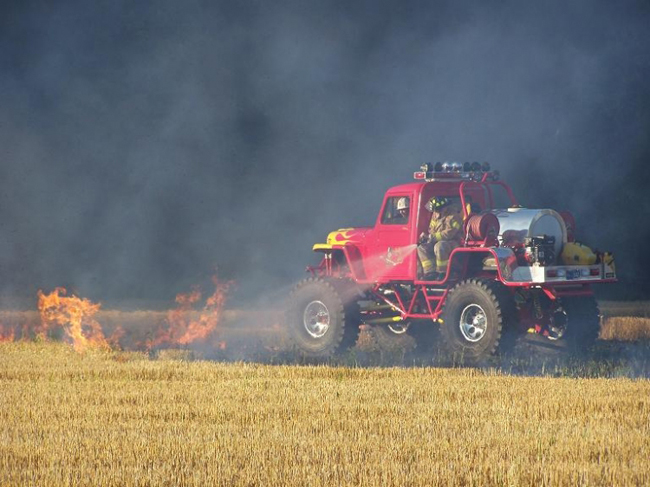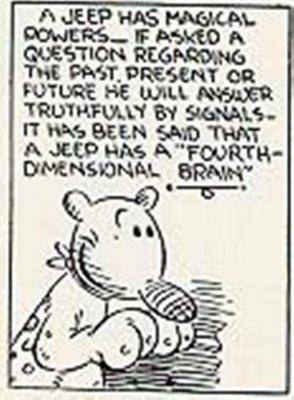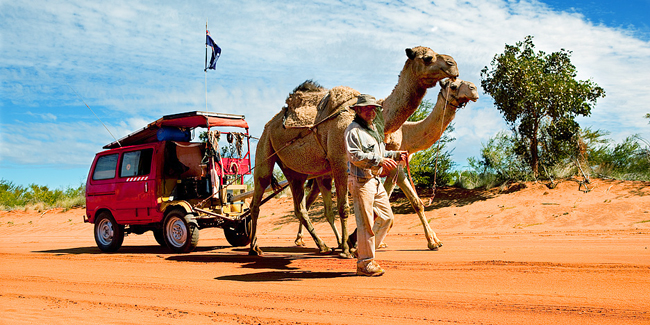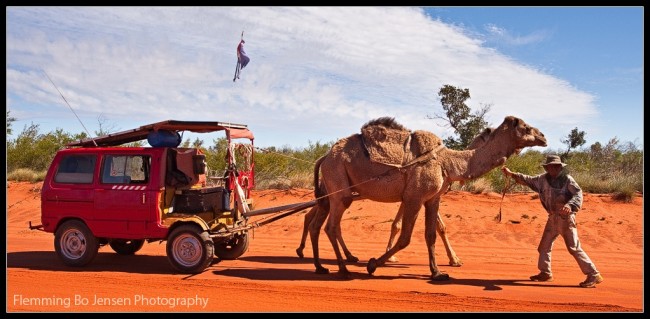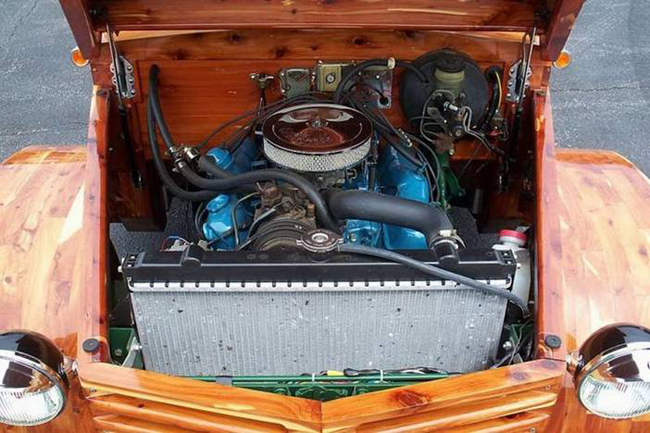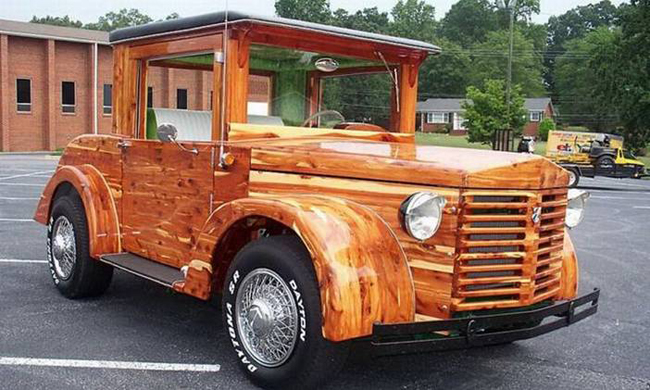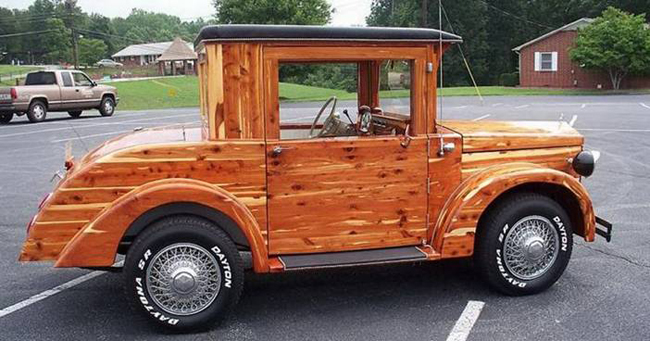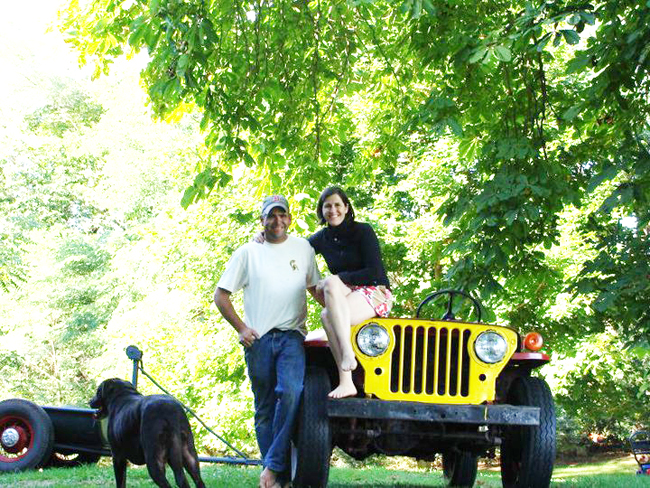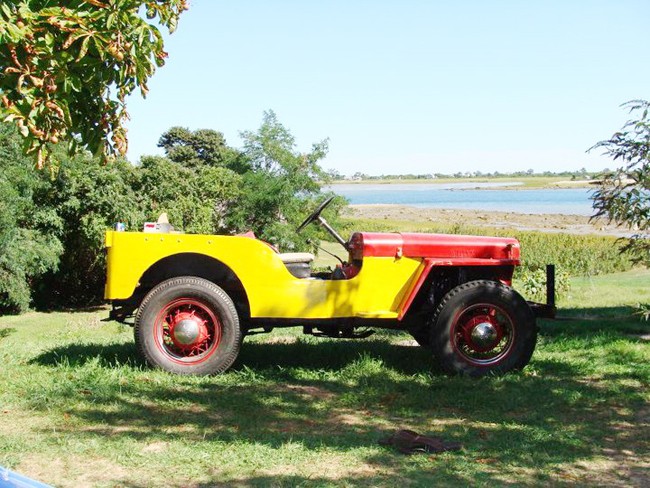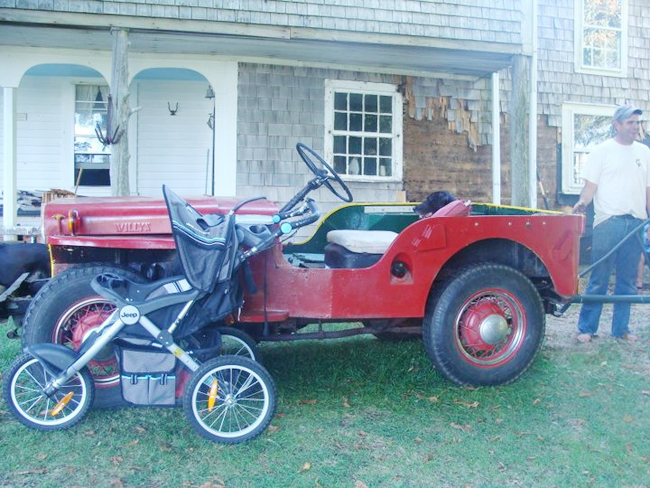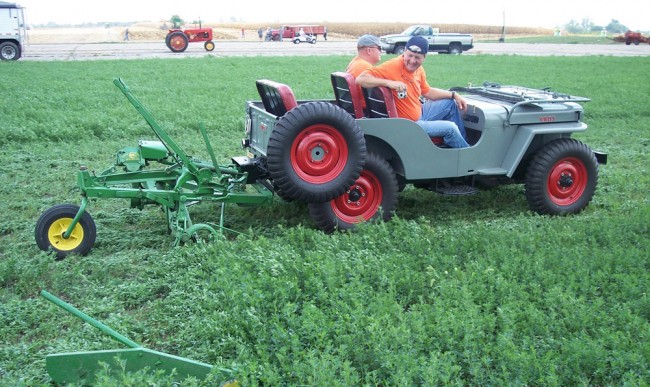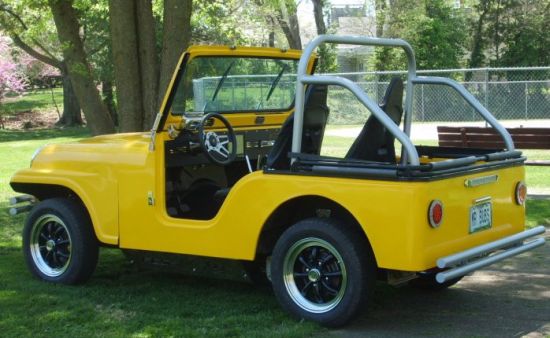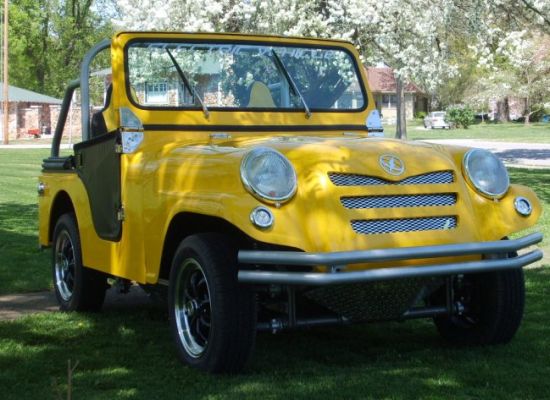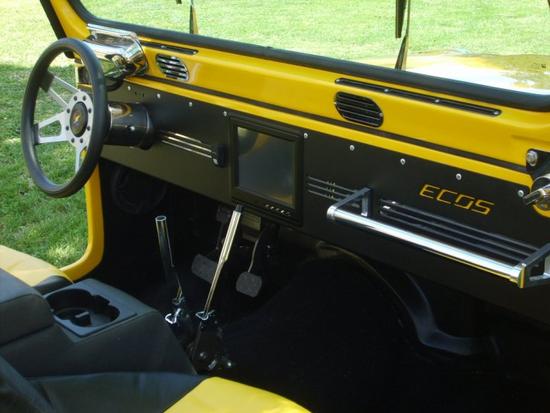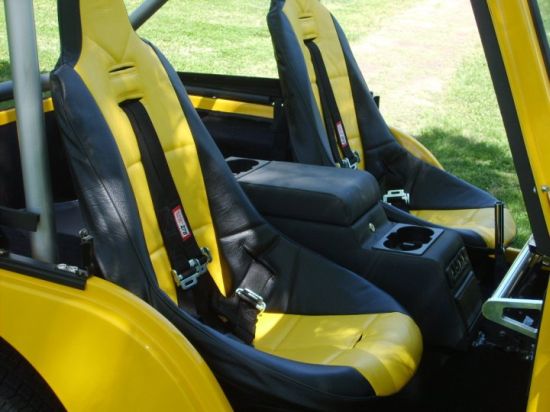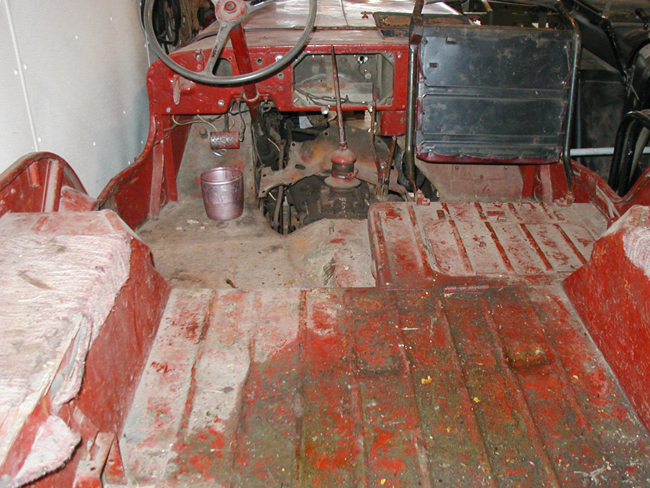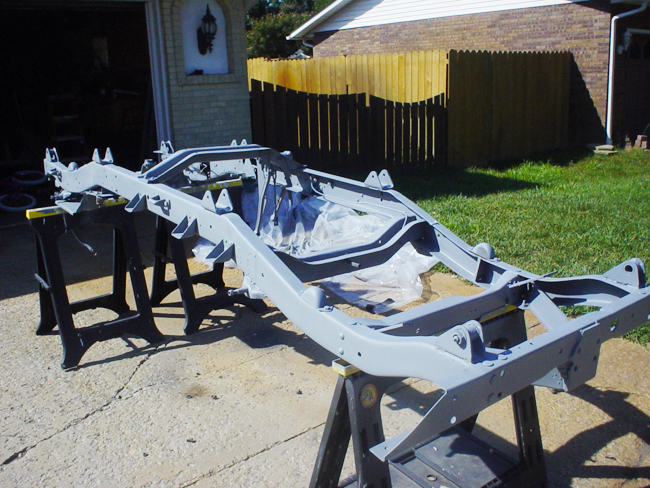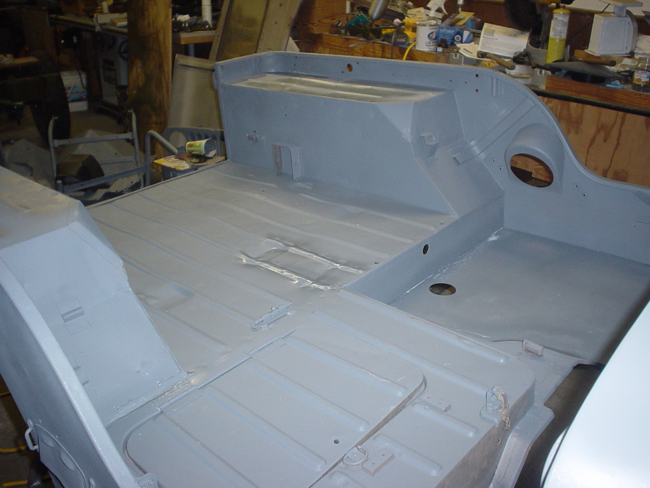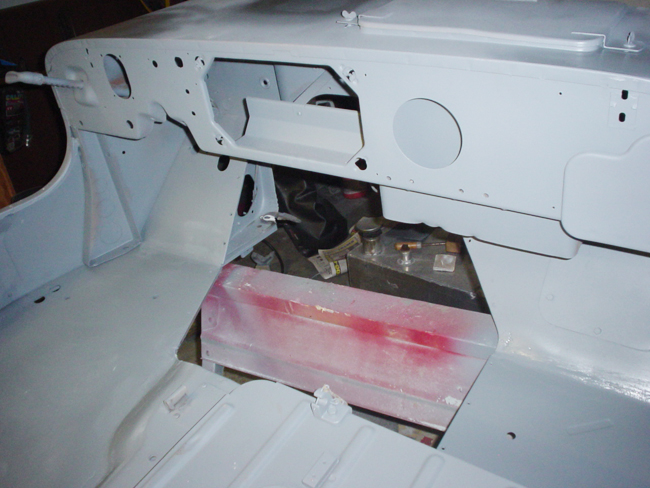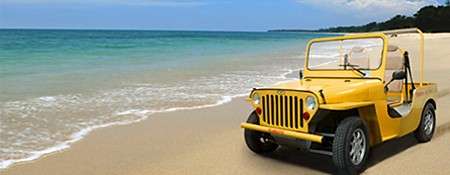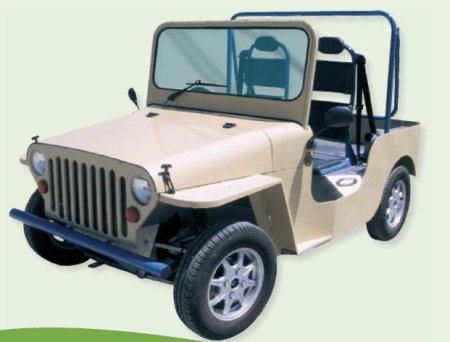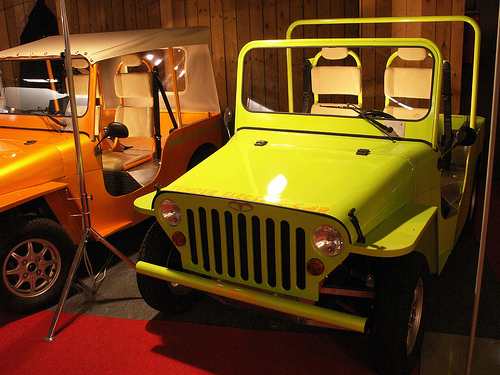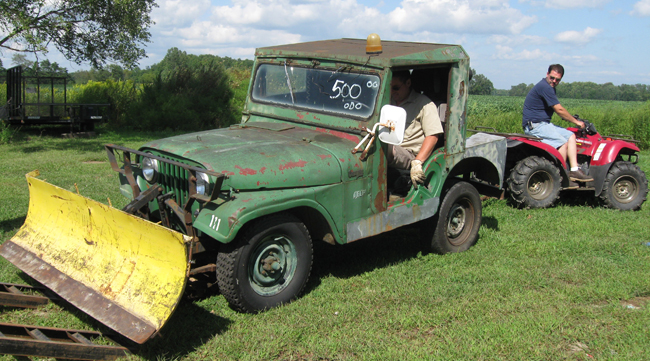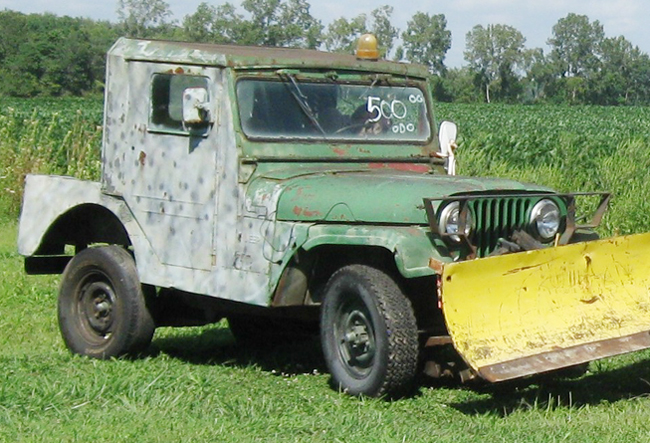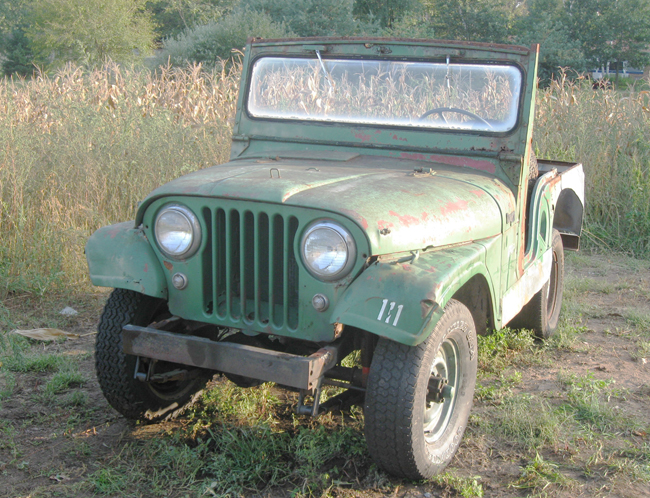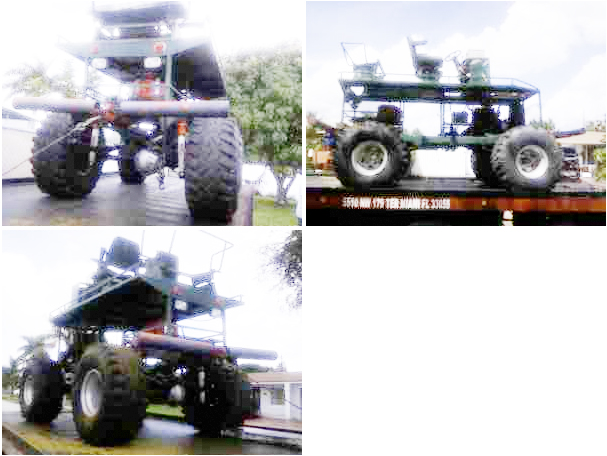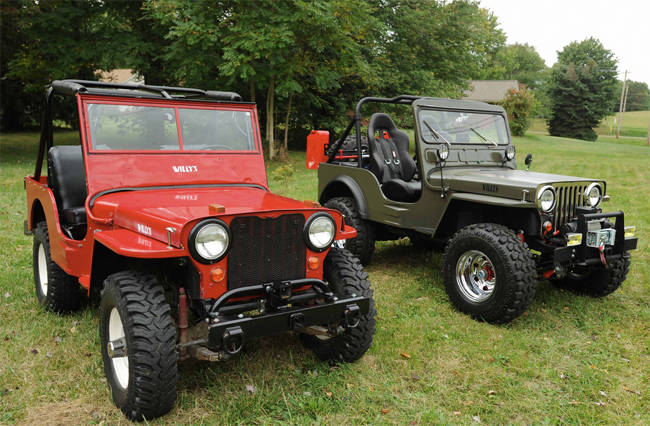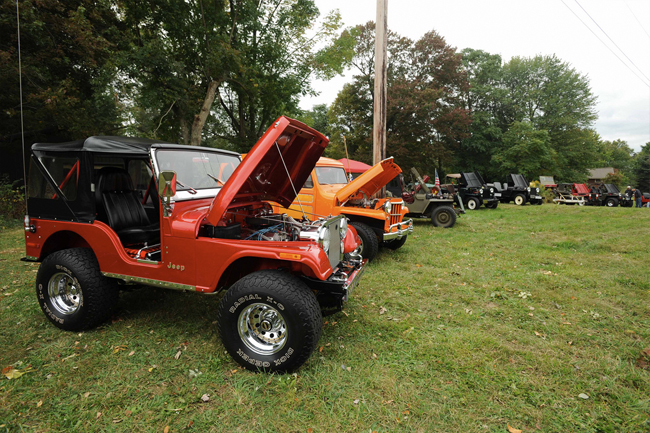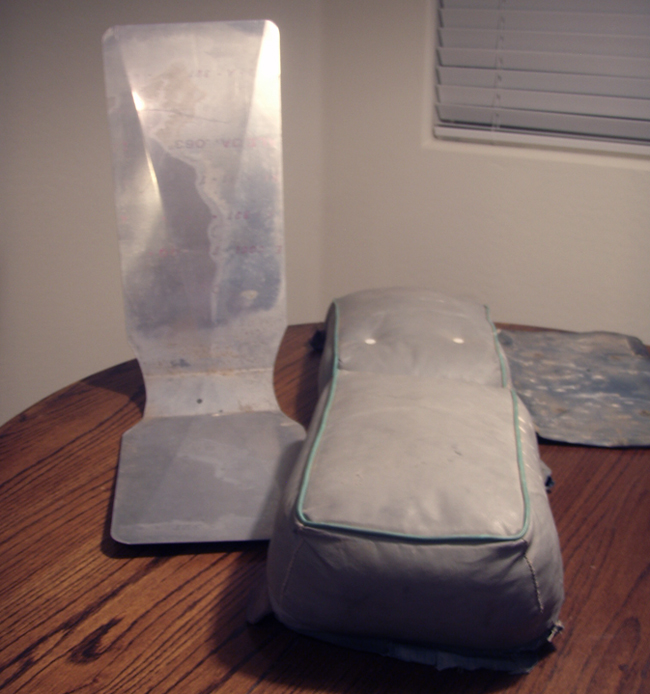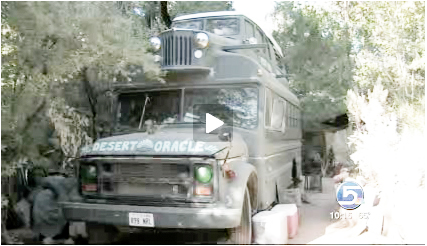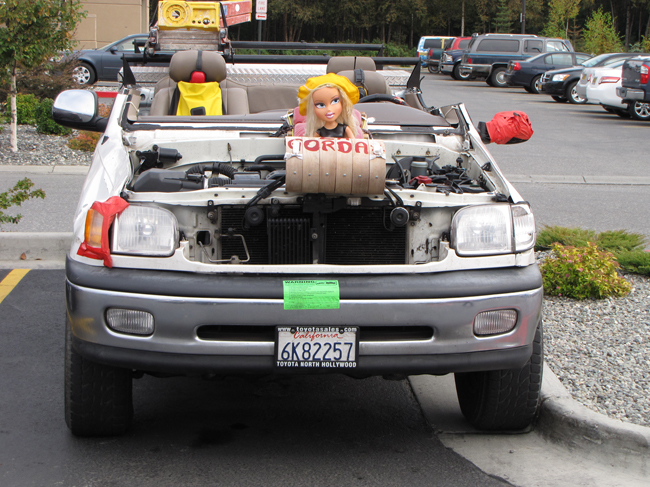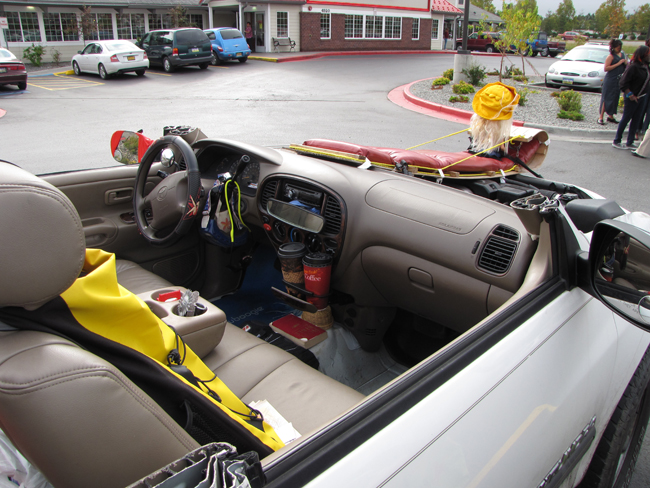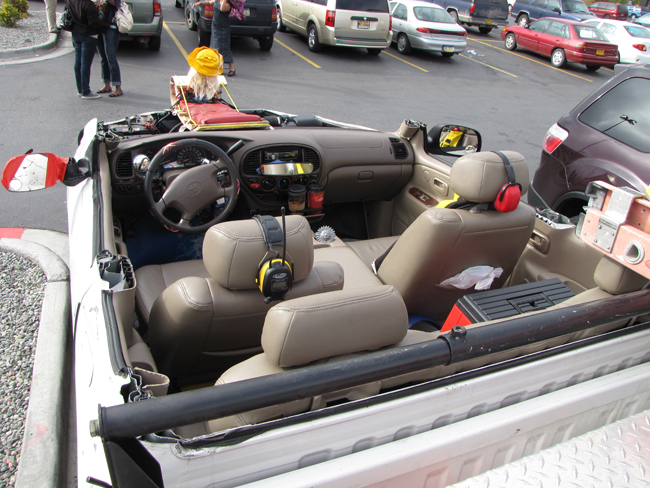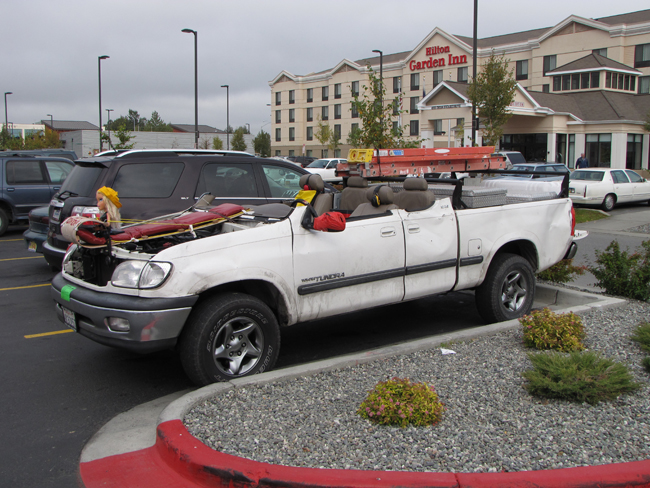I ran across the image below of a Mahindra-built Military CJ-3B on the team-bhp site. After a few searches, I learned that the image came from the CJ-3B Page, which has the below image plus some additional images showing work that was done at UDAY’s shop in India. According to the CJ-3B page, this vehicle shouldered a 106mm gun. Given this fire power, the owner, Anirban, calls the Jeep ‘Agni’, which means the God of Fire. It’s a good name I think.
Features Research Archives
Sam Gives Craig’s CJ-3B a Lift
(Sam, feel free to correct if I have erred with any of my descriptions!)
Sam’s been keeping busy working Craig’s CJ-3B. For example, Craig was complaining that the brakes didn’t work real well. So, Sam took a close look at them and discovered that the jeep was only stopping with one brake! Two of the brakes were completely rusted up and the third brake had suffered a pinched line! So, Sam obtained some brakes off of a Wagoneer (shoot, I can’t remember the details Sam!), installed those and rebuilt the lines. Now it “stops on a dime with 9 cents change” as Sam says.
Another project Sam tackled was the springs. The ride was hard as a rock. Sam told Craig he had a pretty easy solution. Instead of installing new springs, they just needed to pull the leafs apart, clean them up, install new bushings and shackles, and then add a liner between the springs to help quiet the ride and improve the action between the springs. So, Sam put everything back together, saving Craig plenty of money in the process, and the ride improved immensely.
A third project Sam tackled was a lift: Craig wanted the jeep to ride slightly higher, but not as high as a SOA would have been. Instead of using longer shackles, Sam suggested simply adding some blocks between the frame and spring holders. This would provide the lift, but negate the need to change the axle angles. Below are some pics of the finished lift. During the process, Sam also installed new shock mounts in the middle of the frame, which allows for the use of stock shocks.
The blocks were made with 2.5″ x 2″ x 3/16″ square tubing that has been capped on each end. Below pre-paint finished product.
Here is the post paint result of the front hanger (note the color is actually black, but the light faded the color)
You can see the homemade shackles that Sam built which utilize the horizontal piece in the middle. This helps reduce spring sway. He prefers to keep the shackle as short as possible to additionally remove sway.
Here’s a shot of the front of the rear spring.
This shows the ‘new’ brakes, but does not show the lowered top shock mount. It also doesn’t show the updated Rack and Pinion system which should be completed soon (here are some early images and discussion of the process).
The Barfrosttreffet is this Weekend
Even Erlien wrote me today to tell me about the upcoming Barfrosttreffet (early frost gathering) in which he and about 40 other vehicles will participate. Given it will take place in Norway, I suspect it will be plenty cold! Even has offered to take some pics and share them.
Even tells me a number of folks from Norway keep tabs on eWillys, so I thought I’d give a shout out to the Jeep Club of Norway. Launched in 1999, the club has members in areas throughout Norway. Their website with some images to check out, but if you want to read about the club you’ll need to brush up on your Norwegian 🙂 (or use a translator, which is what I did). Thanks for the email Even!
(btw, Even I need you to email at d@ewillys.com … I tried responding to the email addy you sent and it didn’t work for some reason)
A Very Sad Wagon ….
Maggie Mae discovered this terribly sad wagon. This poor thing is now sitting in her driveway. However, looks can be deceiving. It turns out it has a part she has been trying to find. Also, upon closer inspection, she reports the frame appears in good shape.
She writes, “In my defense, it was ‘free for haul away’ and has the 2 barrel manifold I’ve been searching for. The floor is just a couple inches shy of the bottom of the windows, it actually looks a bit better than it should in the back end because of the homemade spring hangers/lift kit. Yes, the grille guard is a piece scaffolding. The gas tank had rusted through and was replaced with a beer keg that was “mounted” on 2×4’s where the passenger rear seat should have been.”
The Bantam BRC-40 T2 & T2E1
UPDATE: These images come from the War Wheels website. There’s a longer discussion no why changes were made to the gun placement.
Here’s what’s likely a 1941 image from warwheels.net of the Bantam BRC-40 T2 with the 37MM Gun on it mounted in the middle of the vehicle:
There were some problems with the T2, so the gun was moved to the back for version 1 of T2E1.
The army preferred this location, because a 2nd version of the T2E1 was developed that lacked a standard body (many more photos here):
Finally, there was also reportedly an anti-tank Willys MB version called the T21 with a75mm mounted in the rear, but I haven’t been able to verify it.
Sam Installs a Rack & Pinion Prototype
Sam, from Flatfender Willys in Colorado, mentioned a few months ago that he figured out how to easily install an off-the-shelf Rack & Pinion into a flattie. He’s installed over 10 of these over that past few years in various rigs with great success.
A number of readers asked for more information. However, Sam chose to delay the information so that he could work with the maker of the R&Ps to develop a Rack designed especially for Jeeps — from old flatties through Wranglers.
What you will see below is the protoype built by the company that Sam has installed into Craig’s CJ-3B. These are early pictures of the process. Once Sam finishes testing this prototype, they’ll be available for sale.
1. This first image shows the Rack tucked neatly under the cross member.
2. Here is an underside look at the setup.
3. Here’s a look at the 7/8″ tubing (I think I have that right). The basic Rack was originally designed for a 4000lb truck and then was modified for the Jeep to insure it was strong enough to handle a variety of situations.
4. For the typical installation, you’d leave the stock shock mount (if you have a mount there), and cut the plate flush with the frame. Otherwise, you can just bolt the plate into position. In this case, Sam had made a change to the suspension and moved the mount down.
5. This image shows that the Rack has an even lower profile than the stock system. Note how far lower the stock system extends.
6. This image shows the 1/2″ plate to which the Rack mounts. shows the Rack doesn’t extend far outside the frame.
A WWII Courier Willys
I don’t know anything about this particular jeep except that it is called the “Dixie Flyer”. It seems to be a modified MB with a ‘Courier’ sign in the front and some modifications to the fenders. It also appears to have a gas tank on the passenger side (I think that is what is sticking down under the passenger?). I found this image on the European Center of Military History’s Blog.
Museums: MB at the Cole Land Transporation Museum
This MB is located at the Cole Land Transporation Museum in Bangor, Maine, and has an interesting history. According to the museum’s website, “his 1945 jeep served with the U.S. Army during World War II in Europe. After the war, it was given to the French government (French nomenclature in still on the dashboard). It was rebuilt by the French, declared surplus, and shipped to Duryea Motors, Brockport, New York in 1982. Galen Cole purchased it for display in the Museum.
Perhaps its greatest claim to fame is that the mold for the Maine World War II Veterans Memorial, located on the Museum’s grounds, was formed around this jeep; therefore, the jeep that is the focus of the Memorial is an exact replica of this jeep. It was chosen as the symbol of WWII because personnel of all branches of the service during that war used jeeps-whether generals, admirals, or privates.”
Silly Willy by Wildfire Manufacturing
I spent some time search for Jeeps in Museums today. I discovered that in 1996 a museum with some wwII jeeps closed and the jeeps were purchased and sent to Indiana. After a little searching, I am pretty sure these were bought by the National Automotive and Truck Museum of the United States (NATMUS), located in Auburn, Indiana. This appears to be a pretty sizeable museum with a great collection of both stock and modified vehicles.
Sorting through images at different sites, I did eventually find an image of a GP (to be published later) located at NATMUS. I sent them an email to see if I can get additional images and information (my emails to museums thus far have proven useless so far, with the exception of a gracious and quick response from the York Museum in PA).
 One additional item I discovered while searching through some NATMUS images was this modified Willys Truck hidden in the background of a pic focused on the Popcorn Wagon (see pic to right). Fortunately, I could identify the website emblazoned on the windshield and, viola, I found some great pics of this vehicle to share.
One additional item I discovered while searching through some NATMUS images was this modified Willys Truck hidden in the background of a pic focused on the Popcorn Wagon (see pic to right). Fortunately, I could identify the website emblazoned on the windshield and, viola, I found some great pics of this vehicle to share.
This truck, called Silly Willy, was built by Wild Fire Manufacturing for 1st Attack (Jeffrey Cook is president of both companies). 1st Attack is a company that specializes in the development of offroad emergency vehicles. You might know Jeffrey Cook from his days as owner/driver of the Monster Truck War Wagon that toured nationally.
Here’s some pics of Silly Willy:
The Jeep and its ‘Fourth Dimensional Brain’
The Camel Man of the Outback
It was 25 years ago this winter … ouch .. has it really been that long ago … that I decided to join a small group on a bicycle journey of the South Island of New Zealand. I was only 20, the youngest member of a troupe that ranged from little ol’ me all the way up to a couple who was 55 (and an adorable, long married, in-love couple they were). Over a period of 3 weeks we hiked, biked, helicoptered, jet-boated, trained, vanned, laughed, talked and drank (well, some of us more than others) our way around the south island of New Zealand. For a pretty sheltered kid of 20, it was an eye opening experience.
I certainly can’t forget New Years Night, 1985, in the tourist town of Queensland, where many people around my age gathered in the town square. Everyone wandering around, hugging, kissing and meeting people from all over the world. For a dorky geek like me, it was a temporary slice of heaven as I got to mack with some good looking women. One beautiful young woman from Vancouver and I got along particularly well and …. ahem … back to our story ….
When the 3 week trip in New Zealand was over, and we were all stuffed with Ice Cream (best on the planet — but their cones sucked!), meat pies (these were soooo good), and stories, most of us adventurers returned home; however, the two ‘guides’ who organized the trip spent the next month or two wandering the Australian Outback in a vehicle they bought in Australia. Several months later, one of the two guides, Brock, tracked me down in the San Juan Islands (I was working up there as a chef). He told me that some day I HAD to go to the outback of Australia and see the stars. He told me that the Outback was truly a unique experience and though we had seen many many stars in New Zealand (very little light pollution there), going to the Outback was even better.
To date, I haven’t made it back to New Zealand nor have I made it to Australia. I haven’t even broken the southern hemisphere since that trip. However, since then I’ve always lusted for Australia.
So, it was with great interest that I have cultivated a new friend from Australia named Hein who recently stumbled upon eWillys. Hein is originally from South Africa and has lived, worked and traveled over much of Africa, Australia and Southeast Asia. Recently, he took a 3 week jeep vacation into the Outback with his wife and daughter and took some photos for us (well, probably for themselves, too 🙂 ). I’ll be publishing the story of the trip in his jeep in the next couple days. In the meantime, one the interesting side stories of the trip involved meeting the Camel Man.
The Camel Man
Hein writes, “I would have loved to spend more time with the Real Camel-man, but it was too early in the day and we were going in opposite directions. Apparently he worked in the mines, oil and gas industry for many years, of which there is plenty out there believe it or not, and just got fed-up with the constant rat-race after money. That old fellow has been doing circuits of the desert for more than a decade with that contraption, at 20 km a day and no towns for up to 800 km in some stretches, can you imagine that life?
I suspect the little van might have had a motor in it initially. When that gave up the ghost he just reverted to a more reliable source of motivation. In parting I actually told him that I might just come and join him in another decade perhaps? I am sure he has a few choice stories to tell and I could really enjoy listening to them while the camels plodded along or over a few camp-fires.”
Based on Hein’s description, I managed to find a couple blog websites which record other run-ins with the Camel Man. They noted he wore a special mosquito mask to keep the flies off and he also had one for his dog, though Hein never mentions seeing the dog. So, on your next trek through the Outback, keep your eyes pealed for this one-of-a-kind traveler. Thanks Hein!
Here’s Hein’s photo:
This photo is from Rod Thomas’s blog:
This image is from Flemming Bo Jensen’s blog:
Wooden Car
Tommy emailed me this unusual build (note it is a car and not a jeep or 4×4). After a little searching, I found this on ebay as well. If you haven’t seen some of the wooden jeeps featured over the years on ewillys, check them out. For a really fast wooden car, check out this supercar.
According to the email, it is a wooden body built in 2009. “This custom wooden car rides on a 1986 Toyota truck frame and gets power from a Chrysler 318 engine. It is driven by an automatic transmission and has merely 1,800 miles on its speedometer. The whole body is made of cedar and its interior is just as over-the-top as the exterior.”
You can see many more pics of this on ebay
Yakima Daily Republic reports on First Naches Crossing
 Based on the below news report, August of 1950 was the very first crossing of the Naches Trail by the Yakima Ridge Runners. This information resides on the Nachestrail.org website.
Based on the below news report, August of 1950 was the very first crossing of the Naches Trail by the Yakima Ridge Runners. This information resides on the Nachestrail.org website.
Something I didn’t know about this first crossing was that the jeepers had to use winches to drop their jeeps over the cliff on the west side, just as pioneers had done almost 100 years before (well, they used freshly made cowhide ropes instead of winches).
Note that in transcribing this article into PDF form, the transcriber couldn’t identify everything, so there are a few uncomplete hiccups in the text.
Though the article includes no images, only 9 months later many of these same folks and their jeeps would be photographed by Life Magazine playing in the Yakima Valley hills, sagebrush and mud (included below). You can see all the pics from that here.
Jeeps Follow Trail Carved by Naches Pass Emigrants
08-15-50
By Ted Van Arsdol, Yakima Daily Republic
Ninety-seven years after the first wagon train crossed Naches Pass through the trackless Cascades, 11 Yakima jeep drivers, members of the Ridge Runner club, have completed the same rugged journey.
The jeep caravan returned here yesterday after following the forest-grown trail across the mountains. The jeep riders lowered their vehicles by chains and a winch down the steep face of a cliff on the west side. It was on this same cliff that pioneers of 1853 were forced to dismantle their wagons and lower them by ropes.
W R. (Wally) Klingele, one of the Ridge Runners making the trip said. The group could still see traces of the old wagon trails and the ancient cuts on trees that probably were made by the pioneers. He said there were also grooves on the west side cliff made by the sliding covered wagons.
First Four-Wheel Repeaters
“I believe our trip over the old road was the first one made by four-wheeled vehicles since the pioneer trek,” Klingele said. He had heard of motorcycles going over Naches pass, but doesn’t believe they went down the face of the cliff as the jeeps did.
Members of the Ridge Runners who made the trip were Chet Thompson, Dale Rohn, ___ Golsh, Gordon Buckley, Harlan Beckett, Lyle Christopherson, __ King, Bob Schultz, Pat Mullins and Klingele. Roger Gervais, jeep club initiate, also made the mountain trek.
The group had gone into the [?pass] one week ago from Timothy meadows to Government meadows. They left Saturday from the mouth of American river, went about seven miles by road to Jungle creek camp and then journeyed on by jeep trail to Timothy meadows.
Had to Carve Road
They camped overnight at Timothy meadows and started at [??] am Sunday on the trip through the woods. It took 11 hours for the caravan to cover the 10 miles to the pioneer cliff. The drivers had to cut and clear a road using shovels and axes.
To reach the bottom of the cliff on the other side, the Ridge Runners hooked one jeep to a tree by a chain, and the man in the jeep used a winch to lower other vehicles down the cliff. [?] used a crank to unwind the winch, while the other Ridge Runners worked with the jeep being lowered to make sure it didn’t go astray.
The 150 foot dropoff was steeply sloped but had a number of ledges. It took 2 1⁄2 hours to lower all the jeeps. The toughest part of the trip came at the end. Yakima’s jeep club spent eight hours covering a mile and a half of the most rugged sort of mountain terrain. The foliage was heavy and many fallen rocks and logs hampered their machines.
After 21 hours on the trail the Road Runners reached Hines forest camp on the west side at 3 yesterday. They covered just 14 miles from the end of the trail at Timothy meadows to the forest camp.
Buttercup — A True Love Story
Buttercup has come home again. Here is the story as told by Buttercup’s current steward.
William writes, “I would like to introduce you to “BUTTERCUP” a 1946 CJ2A. My father “Skip” Taylor bought her in 1973 for $150.00 and brought her out to our family house on Clarks Island in Plymouth Mass.
Out there he put plywood floors in, added yellow paint(out of a can) and named her Buttercup after a cow that was once on the property. For 20 years she was our tractor and stuff hauler. I learned to drive her when I was 10. Sometime in the 80’s Skip added the wire wheels and had a trailer built. By 1990 it was decided that she was getting tired and was replaced by a John Deer tractor.
After a while she was sold to a gentleman with the agreement that my father would get “right of first refusal” if she was ever put up for sale. Well, 3 winters ago that man kept his word and sold Buttercup (painted red) back to us with new floors and a rebuilt original motor.
She is now back on the island, going back together once again. She has new brakes, a tune up, the wire wheels(off a 35 ford) and her bright yellow paint (out of a can). Buttercup is running great and driving the property cleaning up branches and taking the kids out for rides. She is a part of our family and hope to keep her going for another sixty years.”
I asked William about the wire wheels and he said his father had the centers of some jeep rims cut out and welded into the 35 ford rims. Not road safe but good for an island.
Here are some pics of Buttercup. Thanks for sharing William!
A Beautiful Pic of a 1948 CJ-2A pulling a Mower
I found this image at the halfcenturyofprogress blog. I thought it was a cool pic. It wouldn’t surprise me if someone knew who this was ….
Eco Motors ‘Fun’ Vehicle
Continuing with yesterday’s e-jeep, while not a 4wd vehicle, this eco-motor jeep look-a-like appears inspired by the CJ-5. According to ecofriend.org, “The Fun retails for $24,995, though they have an introduction price of $19,995, and can deliver a top speed of 70mph and an operating range of about 100 miles between charges. The vehicle uses the customizable MiMod EV monitoring system from EV Instruments, which is an integrated system of sensors, monitoring logic and operational controls that can be customized to suit any type of EV.”
Here is the website for Eco Motors and the Fun. The company appears to be located in Springfield, Mo.
John’s ‘new’ M-38
John contacted me last month asking me to comment on several different jeeps he wanted to purchase. His goal was to buy an older jeep and had several in his area (midwest) he was choosing between. I thought it might be helpful to share my thought processes involved in helping John.
He narrowed his choice down to between a 42/43 GPW, a 1947 CJ-2A military clone, and a restored M-38 (though missing a few of he details of a polished restoration). He said he was only going to use the vehicle for around town trips and did not plan to offroad it at all. He asked for my opinion and here are summaries of my responses.
GPW: The GPW looked pretty good, however there had been a good deal of work done to the front areas of the frame (welds along the top and bottom near the bumper brackets, along with indentations along the side of the frame indicate lots of grinding). It had been patched together from the inside and ground down on the outside to make it appear smooth. I’m sure it was solid enough to meet his needs, but I think it dropped the value somewhat. If this is equal in price to the M-38, than personally I would go with the M-38.
CJ-2A Military Clone: I’m sure this would be a solid jeep to drive around, though this jeep should be priced significantly lower than the other two; Given the dirty condition of the engine, I’d be a little worried that the drive train hasn’t been examined recently (perhaps the seller has indicated that the drive train has been rebuilt?). Since it is your desire to have a vehicle that is dependable out of the box, I’m less sure this one is for you. Price-wise, this should be quite a bit less than the others given it’s blended history, say in the $3500-$4500 price range at most.
M-38: It isn’t a perfect restoration (for example, the tranny cover has plenty of dents and imperfections), but it looks very solid, which meets your needs. The M-38 should hold its value well, as there were fewer of these made then most any other model.
Out of the three, I liked the M-38 best for him, as the seller had good pics showing the initial state of the vehicle before restoration, during restoration and after restoration. There was also room for John to make value-added improvements, such as adding stickers and other details.
John has owned it a few weeks now and I asked him how he liked it. He wrote back, “I know that it will have issues only because it is an old jeep. It has lots of funny noises and stuff that I’m not used to. It took me awhile to get used to a choke and floor start and throttle. It has the overdrive which i guess i should just leave alone. The guy i got it from forgot to put new cotter keys in the whole front end so that spooked me after I found it but no problem. He left one of the plugs out of the front steering knuckle so I’m going to have to get one. He welded new bracing underneath and did a pretty good job, but there are a couple of spots that could have been better. The motor really seems to run good. I’m still kind of terrified of the 24 volt system like if it ever stalls how the hell do you jump it. I’m kind of getting used to the shift pattern and double clutching to get in third without a small grind but its ok. All in all, I didn’t get it for a show jeep, just for tooling around town. My town is around 14 thousand people and they have never seen anything like this. The little kids give me the thumbs up and the old guys smile.”
Congrats John! Here are some pics. In the first two you can see the pre-restoration starting point. The work was done by Eric out of Granite City, Illinois.
Here, much work has been done.
Now it is close to being finished and readied to be sold:
John added some stickers and now has a great little jeep:
The Tender Scarlette — an e-Jeep from France
UPDATE: I visited the Tender Website … there is a long video on the front page showing all aspects of this 4wd e-vehicle. Truth be told, they had me at “sexy french woman hops in the front seat and takes off”
I ran across this post and image of what appears to be a small, electric jeep on a forum based in the philippines. After more searching, I discovered this e-vehicle is sold in France and found out more about it from autoblog.com, which has covered this in a couple articles (here and here).
From the autoblog post, here is some information: “You can have it in two flavors, which depends on your driver’s license. If you are 16 and have a basic motorcycle license (called A1 in Europe) you can drive one of this cars which is homologated as a quadricycle. Performance is then quite discreet, limited to 45 km/h (slightly more than 30 mph) and it can’t be driven on highways. However, if you have a regular car license (B1), the car can run up to 80 km/h and can run on highways. The engines can yield 4 kW, 8 kW or 12.8 kW of power depending on the configuration of the vehicle.
The car is a real 4WD with four motors, one for each wheel. The electricity is stored in the floor in 12 lead-acid batteries that store 48 V and 240 Amperes each. It’s enough to drive the car up to 100 km (60 miles). Lead acid batteries were used because they are reliable, have a decent life span (claimed to be from 50,000 to 70,000 km) and low cost of substitution (around 2,200 EUR) when they do die out.. The cost of the car is between 10,000 and 15,000 EUR, depending on options.”
Saving A CJ-5 from a field
One day a while back I got an email from a new reader named Jan. She spotted a CJ-5 sitting in a field for $500 and had a question about the VIN# and the model. We solved the VIN question and then I learned more about how Jan acquired this Jeep.
Jan wrote, “I really didn’t buy it, just offered to get it off his farm. He had a sign on it for $500.00 or best offer. All my friends are laughing at me and indicating it’s the uglist thing they ever saw…… but I fell in love with it!”
After bartering for the Jeep, Jan managed to sell the plow locally, which meant she was actually up a few hundred dollars. However, the body was so bad she knew she had to replace it, so she located a fiberglass tub for cheap in Indiana. She has also found a local mechanic that verified the frame was in good condition and the engine should restore easily. So, hopefully, next spring Jan will be driving around in a “free” jeep. Congrats Jan!
Here’s is the jeep with the top removed.
And here is the ‘new’ fiberglass body
1953 ‘Jeep’ Buggy Miami, Fl $2000
I’m not sure if this has any ‘jeep’ or ‘willys’ left in it, but it sure is unusual.
“1953 jeep buggy in great shape. 4cyl, 4×4 wheel drive and 2 wheel drive.front and rear dana 44’s with 513 gears, buggy has all aluminum floors with gun racks and lights. will go any where. This buggy could use alittle tlc but it is what it is. It’s made for fun not for looks. Perfect for hunting season and priced to sell quick. No low ballers need apply the answer is no! Possible trades. if interested please call me at 786-285-4980”
Pics from Bob’s Flatfender Weekend…
Bob’s flatfender weekend was a success!
Bob reports, “Morning David, our show turned out great. We had 13 Jeeps show up, 12 of which were Willys Jeeps. Everything from a 1942 MB to two 1953 CJ3Bs, including mine. It was great to make new friends and catch up with old friends. We had a nice campfire all day long and had a free lunch for all to enjoy. I also want to thank everyone for the generous donations to help offset the cost of renting a port-a-john and buying the food, as well as showing up on a chilly morning.”
You can see all the photos here. I’ve included a couple below:
Center Seat for Willys
I recently made a note about a ‘3rd’ seat that sat between the front seats of an old Willys and that I couldn’t find any information about it on the web. Well, Ron has such a seat in his jeep and shared some pics with us. These appear to be pretty rare, based solely on the fact that I haven’t seen any of these attached to jeeps for sale (that is until I saw one recently). Thanks Ron!
Ron wrote, “You were wondering about the “3rd” seat or center seat on one of your adds. You advised that you had researched and could find nothing about them. I have one of these seats. They were offered by Willys to make the bucket seats into a bench (in theory). They work so-so. Mine came with my Dad’s 1960 Willys CJ-5 jeep, purchased brand new from Dold Auto in El Centro, California (the jeep is mine now). It was apparently an option. The upholstery is shot on mine but they are easy to restore as the base is a single piece of stainless steel formed like a seat. The upholstery slips on like a sock, one for the back and one for the seat. I can still remember the day we brought the jeep home, I was 9 at the time, seem like yesterday.”
This Idea Never Occurred to Me ….
Brett spotted this unusual blend of Willys Wagon and GMC(?) Bus. I can’t say it is the first thing I’d think of when pondering what to put on a bus. Click on the pic below and it will take you to the video. This Bus’0 Wagon is 29 seconds into the video.
Kevin Paints His Wagon — With some Helpers
Kevin painted his wagon with some unusual help …
Kevin writes, “I Finally got good help on my ’62 Willys Wagon rebuild…it didn’t hurt either to wear my “Big Daddy Roth” – Rat Fink t-shirt for inspirational artistic talents…and yes, in tradition of an old time build, I’m painting it outdoors.”
Only in Alaska?
Take one Tundra Truck, plugin your Sawzall and, viola, you too can have a vehicle like this ….
Paul spotted this strange creature. It wasn’t until I saw the last picture that I discovered it was a Tundra Truck.
Paul writes, “The Goddess and I went out to eat yesterday evening (it was another one of those all you can eat and keep down places) and while walking across the parking lot I saw a modified Toyota extended cab pickup truck. This truck had California plates on it so I guess the driver had a bit of bad luck on the drive north because the damage to the body was substantial. Along with every sheet metal panel being dented, yards of tape were used to keep the headlights from falling out, the windshield and hood were missing and actually the entire top had been cut off so there were goggles hanging in the cab for the driver and passengers use. A small rear view mirror was attached to the steering column but the best touch was a bible resting on the transmission hump [editors note: If i were driving this, I might want a bible nearby, too].”

